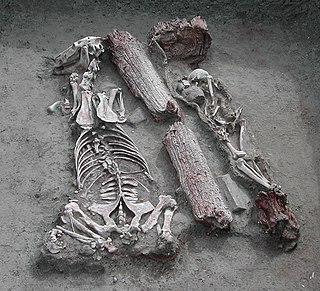
The Pazyrykburials are a number of Scythian (Saka) Iron Age tombs found in the Pazyryk Valley and the Ukok plateau in the Altai Mountains, Siberia, south of the modern city of Novosibirsk, Russia; the site is close to the borders with China, Kazakhstan and Mongolia.
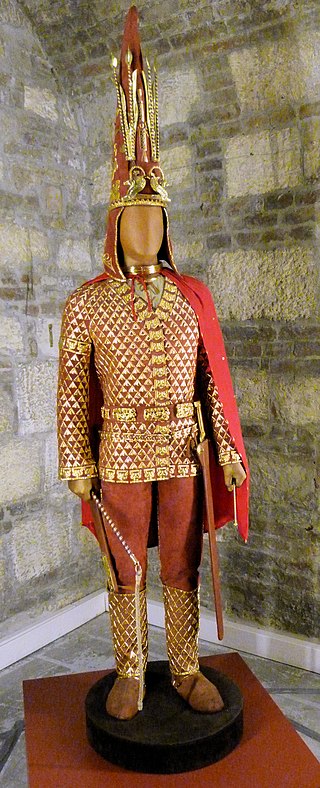
The Saka, Shaka, or Sacae were a group of nomadic Eastern Iranian peoples who historically inhabited the northern and eastern Eurasian Steppe and the Tarim Basin.

A kurgan is a type of tumulus constructed over a grave, often characterized by containing a single human body along with grave vessels, weapons and horses. Originally in use on the Pontic–Caspian steppe, kurgans spread into much of Central Asia and Eastern, Southeast, Western and Northern Europe during the 3rd millennium BC.
The Pazyryk culture is a Saka nomadic Iron Age archaeological culture identified by excavated artifacts and mummified humans found in the Siberian permafrost, in the Altay Mountains, Kazakhstan and nearby Mongolia. The mummies are buried in long barrows similar to the tomb mounds of Scythian culture in Ukraine. The type site are the Pazyryk burials of the Ukok Plateau. Many artifacts and human remains have been found at this location, including the Siberian Ice Princess, indicating a flourishing culture at this location that benefited from the many trade routes and caravans of merchants passing through the area. The Pazyryk are considered to have had a war-like life. The Pazyryk culture was preceded by the "Arzhan culture".
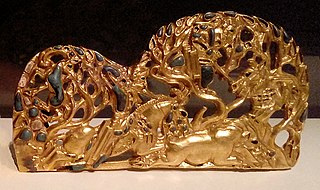
Scytho-Siberian art is the art associated with the cultures of the Scytho-Siberian world, primarily consisting of decorative objects such as jewellery, produced by the nomadic tribes of the Eurasian Steppe, with the eastern edges of the region vaguely defined by ancient Greeks. The identities of the nomadic peoples of the steppes is often uncertain, and the term "Scythian" should often be taken loosely; the art of nomads much further east than the core Scythian territory exhibits close similarities as well as differences, and terms such as the "Scytho-Siberian world" are often used. Other Eurasian nomad peoples recognised by ancient writers, notably Herodotus, include the Massagetae, Sarmatians, and Saka, the last a name from Persian sources, while ancient Chinese sources speak of the Xiongnu or Hsiung-nu. Modern archaeologists recognise, among others, the Pazyryk, Tagar, and Aldy-Bel cultures, with the furthest east of all, the later Ordos culture a little west of Beijing. The art of these peoples is collectively known as steppes art.
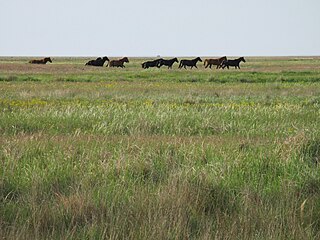
The Pontic–Caspian Steppe, extending across Eastern Europe, is formed by the Caspian and Pontic steppes, which stretches from the northern shores of the Black Sea to the northern area around the Caspian Sea, where it ends at the Ural-Caspian narrowing, which joins it with the Kazakh Steppe in Central Asia, making it a part of the larger Eurasian Steppe. Geopolitically, the Pontic-Caspian Steppe extends from northeastern Bulgaria and southeastern Romania through Moldova and eastern Ukraine, through the Northern Caucasus of southern Russia, and into the Lower Volga region where it straddles the border of southern Russia and western Kazakhstan. Biogeographically, it is a part of the Palearctic realm, and of the temperate grasslands, savannas, and shrublands biome.

The Ordos culture was a material culture occupying a region centered on the Ordos Loop during the Bronze and early Iron Age from the 6th to 2nd centuries BCE. The Ordos culture is known for significant finds of Scythian art and may represent the easternmost extension of Indo-European Eurasian nomads, such as the Saka, or may be linkable to Palaeo-Siberians or Yeniseians. Under the Qin and Han dynasties, the area came under the control of contemporaneous Chinese states.

The Issyk kurgan, in south-eastern Kazakhstan, less than 20 km east from the Talgar alluvial fan, near Issyk, is a burial mound discovered in 1969. It has a height of six meters and a circumference of sixty meters. It is dated to the 4th or 3rd century BC. A notable item is a silver cup bearing an inscription. The finds are on display in Nur-Sultan. It is associated with the Saka peoples.
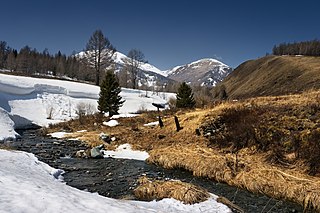
Katonkaragay, also spelled Katon-Karagay is a district of East Kazakhstan Region in eastern Kazakhstan. The administrative center of the district is the selo of Ulken Narym (Bolshenarymskoye). It is the easternmost district in Kazakhstan. Population: 28,008 ; 30,056 ; 45,149.

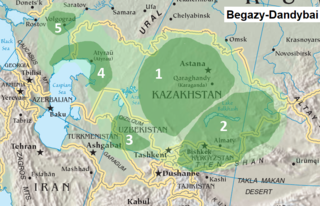
Begazy-Dandybai culture is a late Bronze Age culture of mixed economy in the territory of ancient central Kazakhstan, Kyrgyzstan, and Uzbekistan, that flourished from 13th to 10th centuries BCE, centered at Saryarka region. The culture, with its megalithic mausolea was previously dated between the 12th and 8th centuries BCE. The culture was discovered, first excavated, and published in the 1930s-1940s by M.P. Gryaznov, who took it for a local version of Karasuk culture. In 1979 the Begazy-Dandybai culture was described and analyzed in detail in a monograph by A.Kh. Margulan, who systematically reviewed accumulated material and produced description of the archeological culture. The most famous monuments of Begazy-Dandybai culture are Begazy, Dandybai, Aksu Ayuly 2, Akkoytas, and Sangria 1.3, it was named after the first two archeological sites.

Central Asian art is visual art created in Central Asia, in areas corresponding to modern Kyrgyzstan, Kazakhstan, Uzbekistan, Turkmenistan, Azerbaijan, Tajikistan, Afghanistan, Pakistan, and parts of modern Mongolia, China and Russia. The art of ancient and medieval Central Asia reflects the rich history of this vast area, home to a huge variety of peoples, religions and ways of life. The artistic remains of the region show a remarkable combinations of influences that exemplify the multicultural nature of Central Asian society. The Silk Road transmission of art, Scythian art, Greco-Buddhist art, Serindian art and more recently Persianate culture, are all part of this complicated history.
The Tasmola culture was an early Iron Age culture during the Saka period in central Kazakhstan. The Tasmola culture was replaced by the Korgantas culture.
The Nazarbayev Center is a multifunctional scientific, analytical, humanitarian and educational public institution in Kazakhstan.

The art of Kazakhstan covers all forms of art created throughout history by the peoples living on the territory of modern-day Kazakhstan. Throughout most periods, much of the population of Kazakhstan was nomadic, or at least moved regularly across the vast country. The great majority of the art of Kazakhstan is applied art: the decoration of practical objects, including household utensils and patterned harnesses, through art forms such as carpet-weaving, pottery, and leatherwork. The art of Kazakhstan also includes architecture, fine arts, and sculpture.

The Scythian culture was an Iron Age archaeological culture which flourished on the Pontic-Caspian steppe in Eastern Europe from about 700 BC to 200 AD. It is associated with the Scythians, Cimmerians, and other peoples inhabiting the region of Scythia, and was part of the wider Scytho-Siberian world.

The Archaeological Museum of Termez is a museum in the city of Termez, modern Uzbekistan. The artifacts contained in the museum are mainly linked to the Graeco-Bactrian and Kushan periods. Some artifacts, such as the seated Buddha under the Bodhi tree or head of the Kushan prince are actually copies, the original of which are located in the History Museum of Tashkent and in the Hermitage Museum in Saint-Petersburg.

Shilikty, formerly Chilikti, also more precisely Baigetobe Kurgan in Shilikty Valley, is an archaeological site in eastern Kazakhstan, located in the Chilik river basin. At this site, numerous 8th-6th century BCE Early Saka kurgans were found. Carbon-14 dating suggests a more refined date of 730-690 BCE for the kurgans, and a broad contemporaneity with the Arzhan-2 kurgan in Tuva.


















